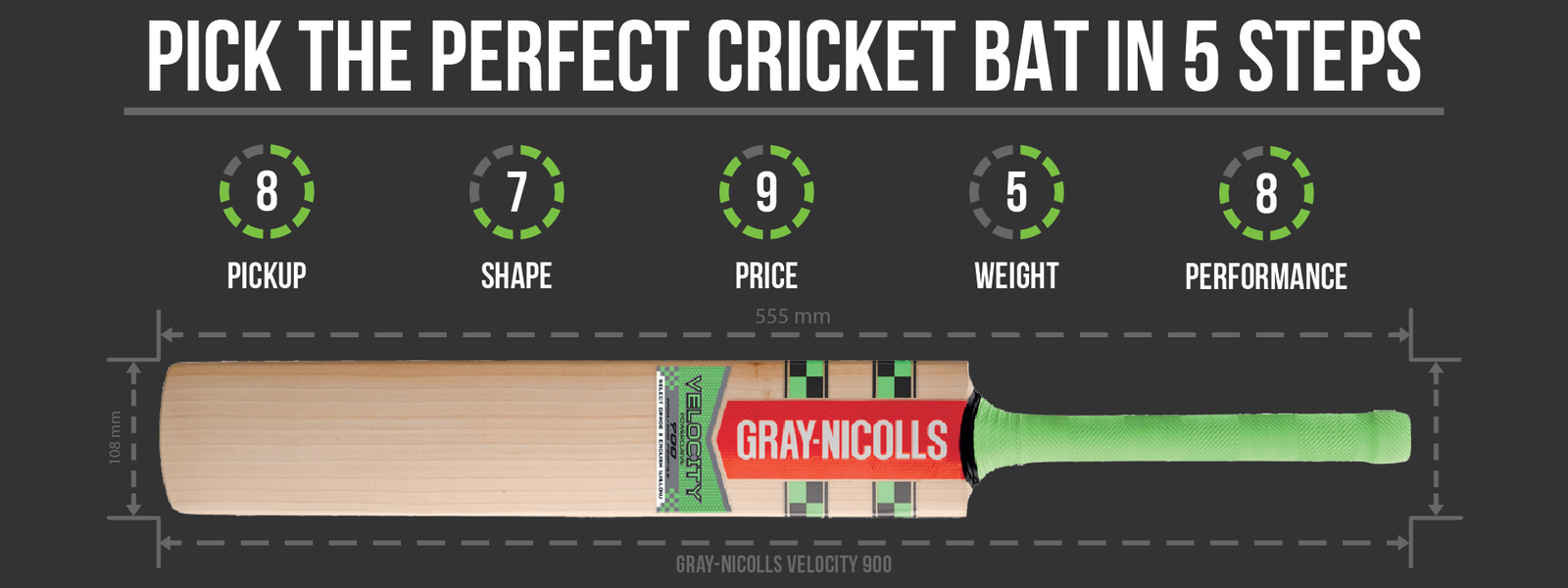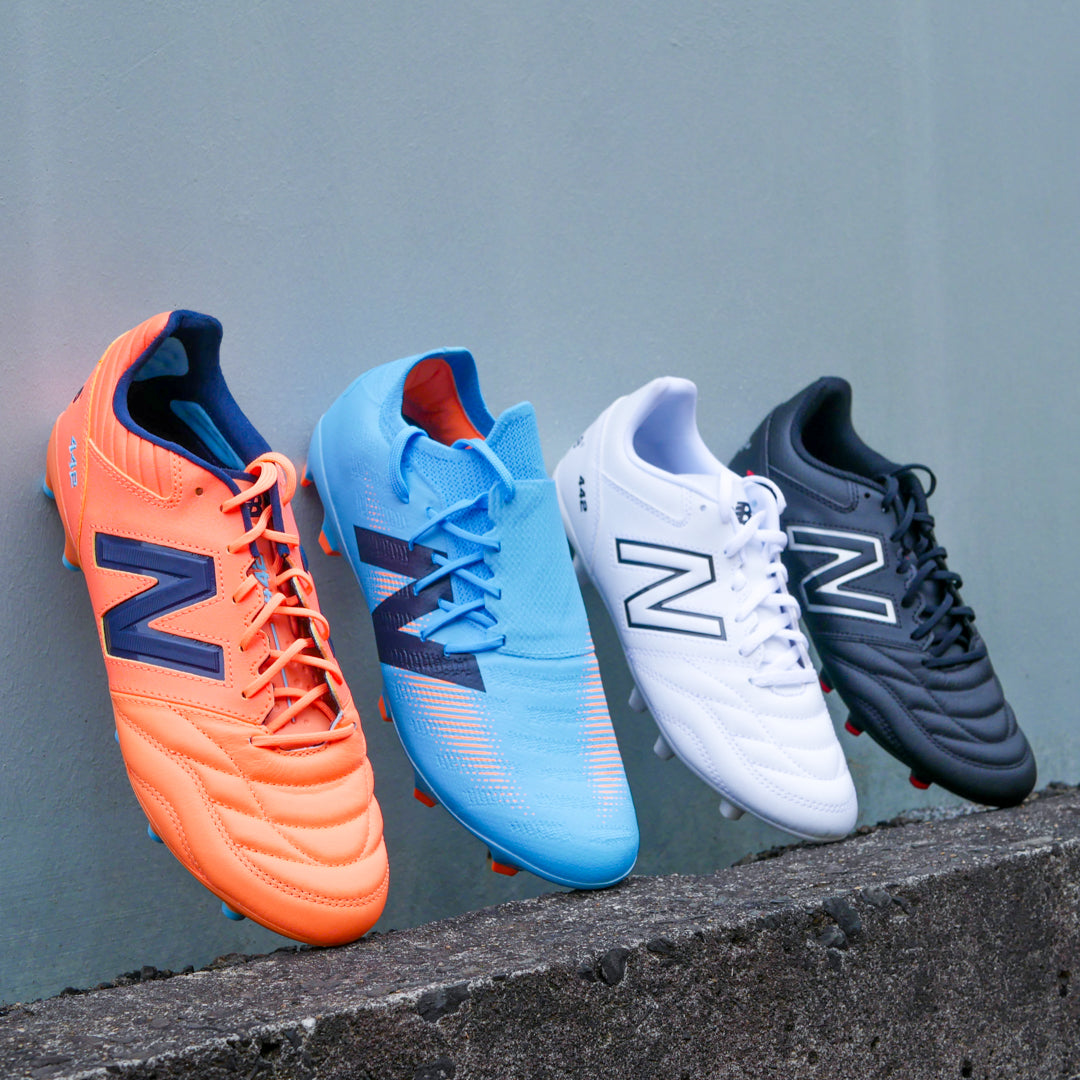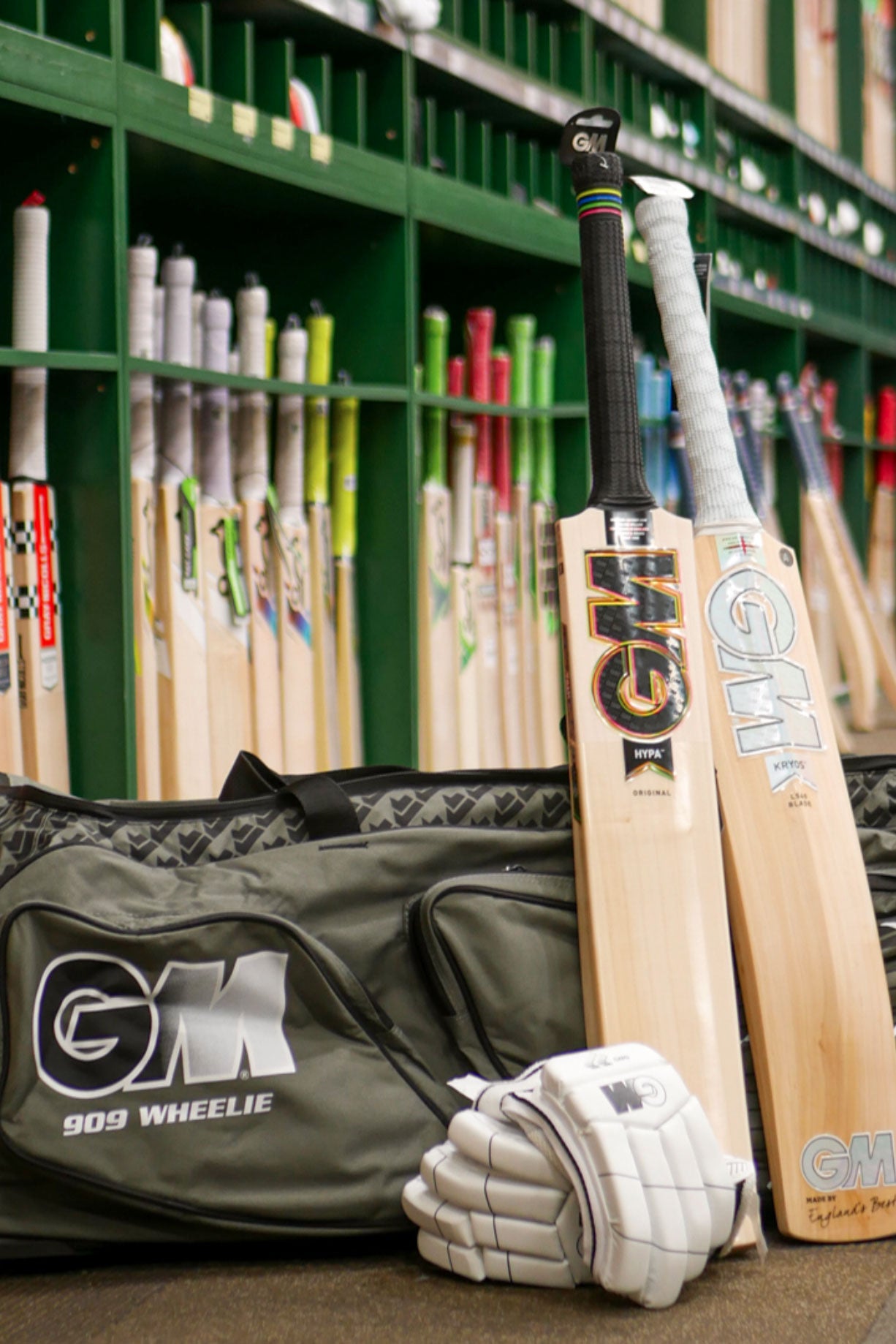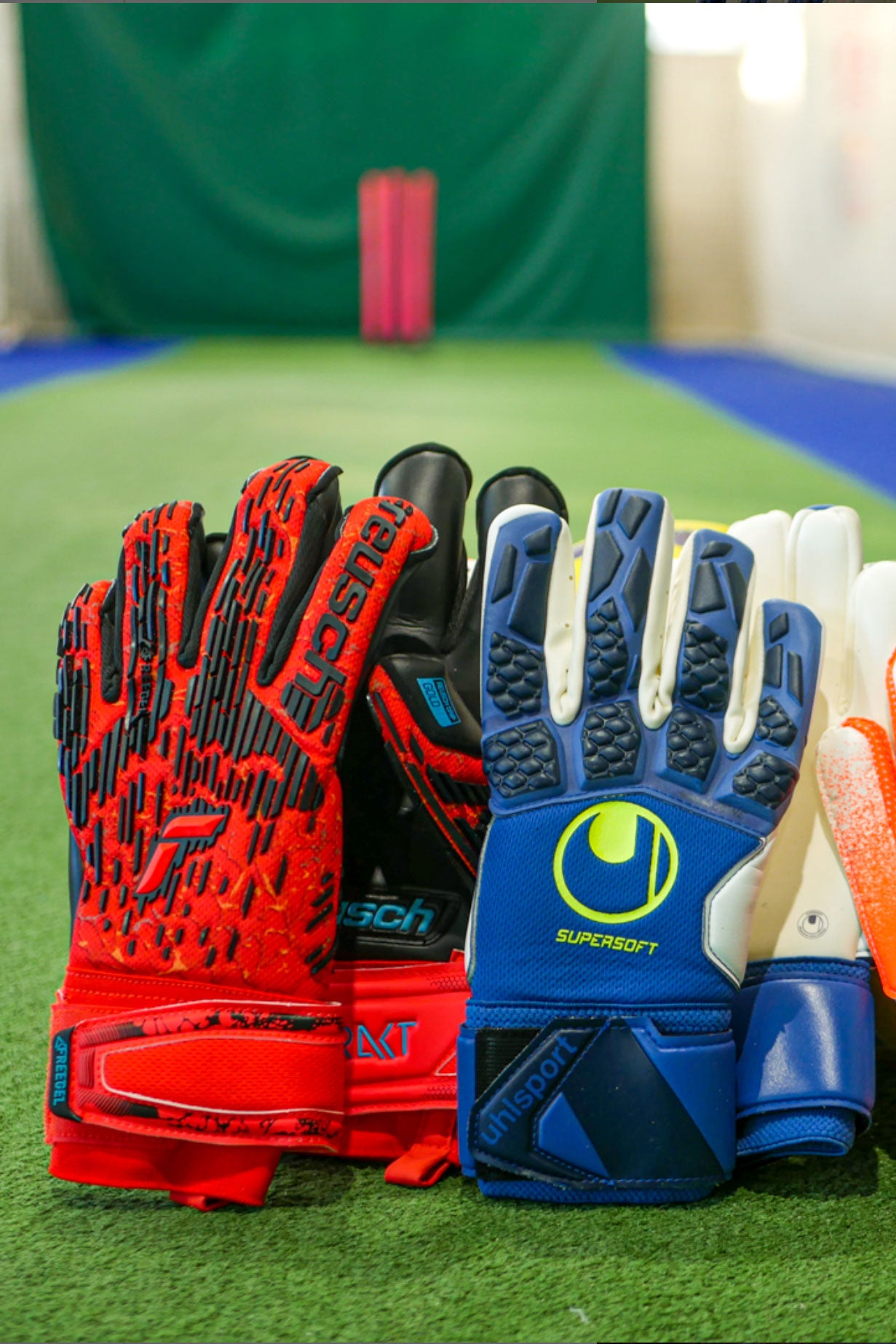Free knocking-in on all cricket bats
BUY NOW, PAY LATER WITH AFTERPAY
Free knocking-in on all cricket bats
BUY NOW, PAY LATER WITH AFTERPAY
Soccer
brands

How to Choose a Cricket Bat
February 05, 2019 14 min read
Wondering how to choose a cricket bat? It’s about picking the right willow, size, weight, and handle type. This guide will break down each factor so you can find the perfect bat for your playing style.
Choosing the perfect cricket bat can be a hard decision. It can be overwhelming when walking into a Kingsgrove Sports store and seeing a wall of bats lined up from edge-to-edge. Which one will perform the best? Which one will last the longest? Which one can I afford? We’ve broken down this complex buying process into a few simple steps to assist you in this decision.
Key Takeaways
-
Choose between English and Kashmir willow based on performance needs and budget; English willow offers superior quality, while Kashmir willow is ideal for beginners.
-
Select the right cricket bat size based on the player’s age and height to ensure optimal control and reduce injury risk.
-
Understand key bat features such as weight, handle type, and sweet spot position to enhance performance and comfort during play.
1. Set A Budget
Having a budget set for your cricket bat is always a good idea before walking into one of our stores. It helps you narrow down your possible options and helps our bat specialists to look for bats in your price range. Although price is not the ultimate determining factor it needs to be considered.

Bats often come in ranges with varying models with the same shape. If a player likes the style and shape of the bat they would then choose the specific model that fits within their price range.
2. Determine The Shape and Your Style of Play
Bat makers create cricket bats with varying profiles, edges, scallops, sweet spots and so on. These aspects of a bat change how the bat is shaped and hence the performance of the bat depending on the player. Because it is hard for an individual to determine what shape is best for them our bat specialists will help you in this process.

Most bats are designed for all styles of cricket: T20, ODIs or Tests. However, some bats may be tailored to specific styles like T20 cricket, such as the Kookaburra Blaze Maximum, which is shaped for this style of cricket.
Players should also determine how they play the game. Are you more front-foot dominant or back-foot dominant? Bats can be designed with the sweet spot better positioned to increase value of stroke play. If you like to play off the front-foot have the sweet spot positioned mid-to-low. If you prefer to play off the back-foot, look at bats that have a sweet spot placed mid-to-high.
3. Choose A Suitable Weight
The next aspect and one of the most important, is weight and pickup. You don’t want a bat which is too heavy or too light as this will ultimately affect how well you play. This is especially important for juniors. Because the biggest bat won’t necessarily make you hit the ball further if you aren’t strong enough to play your shots correctly. Consequently, a bat which is too light may hinder your potential. This is why it’s better to focus on the pickup of a bat rather than weight.
4. Find The Perfect Pickup
We would all love a bat with a massive profile and a very low weight, but this is extremely rare. There has always been much discussion about the heavy bats with massive profile being able to always hit the ball further but we don’t always agree with this. If you select a lighter bat, then most likely the thickness of the profile and edge, will be smaller, but this is not an issue. As everybody is different in terms of their physique and strength, the most important thing is to choose a bat which feels right for you. Most people are unable to differentiate between bats which vary only slightly in weight, it is incredibly difficult to tell the difference between a bat that is 2.8 lbs. and 2.9 lbs. So it’s best to choose a bat that just feels right for you.
5. Look For The Best Performance
There are roughly 5 Grades of willow that bats are made with. Grade 1 tends to be the best performing willow with 8-10 grains and extremely few or no blemishes on the face of the bat. The cheapest bats tend to be made with Grade 5 willow with 4-5 grains and more blemishes on the face.
These grades give a general rule of how well a bat will perform but performance varies from bat to bat. If you need a bat for immediate use, bats with higher grades of willow perform well immediately, while other grades may take longer to play in and reach their optimum performance. In some cases, bats using lower grades of willow may perform better than bats with higher grades of willow.
Best Type of Cricket Bat for You (English vs Kashmir Willow)
When it comes to selecting a cricket bat, one of the first decisions to make is the type of willow. English willow and Kashmir willow are the two primary types used in cricket bats, each offering distinct advantages. English willow bats are preferred by most cricketers for their superior performance, lightweight, and shock-absorbing properties. On the other hand, Kashmir willow bats are more affordable and durable, making them ideal for beginners, training and casual cricket. Brands like Gray-Nicolls, Kookaburra, and SS offer a range of options in both types of willow, catering to different player preferences and budgets.
Grasping the distinctions between these willow types aids in selecting the right cricket bat. English willow, celebrated for its high performance, is frequently chosen by cricketers playing with a leather ball.
Conversely, Kashmir willow offers a budget-friendly and durable option, ideal for practice and recreational play with tennis and rubber balls. Understanding the key characteristics of each type will guide your choice.
English Willow: Premium Performance and Feel
English willow bats are renowned for their high-quality performance and are the top choice for most cricketers. The finest English willow bats are crafted from trees with:
-
A straight grain structure, which minimizes blemishes and enhances performance by providing a better ‘ping’ when striking the ball
-
Lightweight yet strong wood
-
Excellent shock absorption that contributes to better stroke play
The premium quality of English willow bats comes from their fibrous structure, which allows them to absorb impacts efficiently. Properly knocked in and pressed, these bats maintain an optimal moisture content of around 12-15%, ensuring a balance between hardness and flexibility with fewer grains.
These features enable English willow bats to deliver superior ping and lighter pickup, making them the top choice for performance-focused players.
Kashmir Willow: Budget-Friendly and Durable
Kashmir willow cricket bats are an excellent choice for beginners and those playing in more casual or recreational settings because:
-
They are generally more affordable.
-
They are robust, making them suitable for practice and use on rough pitches.
-
They are heavier and less responsive than English willow bats.
-
Their durability makes them a reliable option for players who are still developing their skills.
Kashmir willow is a denser and sturdier wood, which means that these bats can withstand more wear and tear. Despite being less powerful than English willow, Kashmir willow bats offer consistent performance at a lower price point. They are particularly favored in school cricket and casual matches, where affordability and durability are key considerations. Most of these bats perform better using tennis or rubber balls.
For beginners, or those playing casually, a Kashmir willow bat could be an ideal choice.

Cricket Bat Size Guide Based on Age and Height
Choosing the correct cricket bat size is vital for control, shot accuracy, and minimising injury risk. An ill-fitting bat can impede your performance and development. The bat size must match the player’s height and age for a comfortable, effective playing experience. Below is a rough guide to assist in selecting the right size based on height.
This size guide will assist in finding the perfect cricket bat:
-
Junior bats (Sizes 0 to 6) cater to various heights.
-
Harrow/Youth and Small Adult bats suit those transitioning to adult sizes.
-
Senior bats are available in Short Handle (SH) and Long Handle (LH) for adults, with various cricket bat sizes to choose from.
Here’s a detailed look at each category to aid your decision-making.

Junior Bats: Sizes 0 to 6
Junior cricket bats are specifically designed to cater to the needs of junior players, ranging from Size 0 to 6. These bats are suitable for children from 3’7” to 5’5” in height, ensuring a proper fit for better handling and control. For instance, a Size 0 bat is perfect for children under 4 feet tall, typically ages 4-5, while a Size 1 bat is recommended for children between 4 feet and 4 feet 3 inches tall, usually ages 5-6.
As children grow, they will need larger bats to match their height. Size 2 fits children 4 feet 3 inches to 4 feet 6 inches tall, generally ages 6-7, while Size 3 is appropriate for kids 4 feet 6 inches to 4 feet 9 inches tall, typically ages 7-8.
Sizes continue to increase, with:
-
Size 4 suitable for children between 4 feet 9 inches and 4 feet 11 inches tall, generally ages 8-9.
-
Size 5 recommended for players 4 feet 11 inches to 5 feet 2 inches tall, ages 9-10.
-
Size 6 bats designed for children 5 feet 2 inches to 5 feet 5 inches tall, typically ages 10-11, considering bat size player height.
Youth/Harrow Bat and Small Adult Bats: Harrow to Small Adult
Youth and Harrow bats bridge the gap between junior and adult sizes, catering to players who are transitioning from junior bats. Size 6 bats are typically used by players between 5’3” to 5’5”, ensuring a proper fit for their height and playing style. These bats measure 794 mm in length, providing a comfortable and effective playing experience for youth players.
Harrow bats are designed for slightly taller players, usually those who are 5’5” to 5’7” in height. These bats measure 813 mm long and are suitable for young cricketers aged 11 to 13 years. The weights of Harrow and Small Adult bats typically fall between 2lb 5oz and 2lb 7oz, making it manageable for developing players. This size ensures that players have a bat that suits their height and provides the right balance between size and weight.
Senior Bats: Short Handle (SH) and Long Handle (LH)
For adult players, senior cricket bats come in two main types: Short Handle (SH) and Long Handle (LH). Short Handle bats are suitable for players around 5’7” to 6’ tall, offering a length of approximately 857 mm. These bats are designed to provide a comfortable grip and balance for average-sized adults, ensuring optimal performance on the field. When selecting a cricket bat, it’s important to consider the player’s height and comfort.
Long Handle bats, on the other hand, are designed for taller players, typically those 6 feet and above. These bats measure approximately 876 mm in length and feature a longer handle length of 317 mm, providing enhanced grip and comfort for players of varying player height.
The choice between SH and LH bats depends on the player’s height and grip preference, ensuring a proper fit for effective play.
Key Features to Look for in a Cricket Bat
Choosing the right cricket bat involves understanding several key features that can significantly impact your performance and comfort. These features include:
-
Bat weight
-
Balance
-
Handle type
-
Spine profile
-
Sweet spot position
-
Edge thickness
Each of these elements plays a crucial role in how the bat performs and feels in your hands, making it essential to consider them when selecting a bat.
In the following sections, we will break down these key features to help you understand their importance. By focusing on these aspects, you can find a bat that matches your playing style and provides the best performance on the field.
Let’s start with the weight and pickup of the bat, which are critical factors in determining how the bat feels and performs during play.
Bat Weight and Pickup
The weight of a cricket bat is a crucial factor that influences your swing speed, timing, and overall performance. Lighter bats enhance speed and control, making them ideal for players who rely on quick reactions and precise strokes. On the other hand, heavier bats provide more power, but they require better timing and strength to handle effectively.
The term ‘pickup’ refers to how balanced a bat feels in your hands, impacting control and manoeuvrability. A bat with a good pickup can feel lighter than its actual weight, enhancing comfort and performance. Factors such as the bat’s profile, edge thickness, and handle type contribute to how it picks up, making it essential to test a bat’s pickup before making a purchase.
Ultimately, choosing a lighter bat should focus on how it feels during use rather than just its numerical weight.
Handle Type: Round vs Oval
The handle type of cricket bat can significantly influence your grip and control during play. Round handles are typically preferred by players who rely on wristy shots because:
-
They offer more flexibility and ease of movement.
-
They allow for a more dynamic style of play.
-
They are suitable for players who like to manipulate the ball with their wrists.
Oval handles, on the other hand, provide better grip stability and are favoured by players who prioritise directional control. The shape of the handle helps in maintaining a firm grip, reducing the chances of the bat twisting in your hands during powerful shots. The handle is also shaped to enhance comfort and performance. A tip for players is to choose handles that best suit their playing style.
Whether you choose a round or oval handle depends on your playing style and comfort, so it’s essential to test both types to see which suits you best.
Sweet Spot Position: Low, Mid, High
The sweet spot position on a cricket bat can greatly affect your shot effectiveness. A low sweet spot is ideal for players who play on slow pitches and prefer front foot play, as it provides power for driving shots. Mid sweet spots offer a balance, making them suitable for all-rounders who play on various pitch conditions.
High sweet spots are perfect for players who play on bouncy tracks and rely on back foot shots. The placement of the sweet spot influences the bat’s performance based on the pitch conditions and your playing style. Understanding where you typically make contact with the ball can help you choose a bat with the optimal sweet spot for your game.
Pre-Knocked vs Natural Cricket Bats
One important consideration when buying a cricket bat is whether to choose a pre-knocked or natural bat:
-
Knocking-in is a process where the bat’s face is hardened through repeated striking, making it ready for play.
-
Pre-knocked bats are prepped for immediate use, saving you time and effort.
Natural bats, on the other hand, require manual knocking-in before they can be used in matches. This process is crucial to ensure the bat’s durability and performance.These bats may require more time to become game-ready.
Depending on your budget and how soon you need the bat ready for play, you can choose between pre-knocked and natural options.

Best Brands for Cricket Bats in Australia
Australia is home to some of the best cricket bat brands, each offering unique strengths and catering to different types of players. At Kingsgrove Sports, you’ll find a wide range of trusted international and local brands, including:
-
Kookaburra
-
Gray Nicolls
-
SS
-
MRF
-
Gunn & Moore
-
New Balance
-
DSC
-
Symonds
-
SF
-
CA
These brands provide everything from budget-friendly Kashmir willow bats to top-tier English willow bats, ensuring there’s a perfect fit for every cricketer—from beginners to professionals. Choosing a bat from a reputable brand ensures you get a high-quality product designed to enhance your game. Let’s explore some of the standout names.
Kookaburra: Great All-Round Options
Kookaburra bats are renowned for their versatility and are particularly favoured by players seeking dependable performance. Popular models like the Kahuna and Beast cater to different playing styles, offering a significant edge profile that enhances balance and extends the sweet spot across the blade. The super spine profile works in conjunction with the edge to provide increased power and improved pickup. Whether you prefer a flat or rounded face, Kookaburra offers options to suit your preferences.
Gray-Nicolls: Trusted for Balance and Control
Gray-Nicolls bats are trusted by cricketers for their excellent balance and control. Classic models like the Prestige and Players reflect the brand’s heritage of craftsmanship, making them ideal for players who value precision and shot placement. Whether you’re a professional or club cricketer, Gray-Nicolls provides reliable options that are easy to manoeuvre and well-balanced.
SS & MRF: Power-Driven Bats
SS and MRF are powerhouse brands for players who prioritise aggressive stroke play.
-
SS bats like the SS Ton are crafted with thick edges and big sweet spots, giving explosive hitting power.
-
MRF bats—famously used by legends like Virat Kohli—combine robust profiles with balanced pickup. The MRF Genius Grand Edition is a favourite for its large sweet spot and aggressive design.
These brands deliver innovation in design, with enhanced shock absorption and durable grips to suit power hitters.
Kingsport: The Australian Challenger
Exclusive to Kingsgrove Sports, Kingsport bats are designed for both performance and value. Kingsport combines modern profiles, large sweet spots, and lightweight pickup, making them a fantastic choice for players across all levels. Their popularity among club cricketers highlights their excellent quality-to-price ratio.
GM, New Balance, & DSC: Modern Performance
-
Gunn & Moore (GM) are world-renowned for precision engineering, offering bats that balance traditional craftsmanship with innovative shaping.
-
New Balance bats, popularised by players like Steve Smith, feature lightweight pickup and exceptional balance.
-
DSC bats bring a fresh, contemporary approach, offering value-driven performance without compromising on power.
Price vs Performance: What Should You Spend?
When it comes to buying a cricket bat, the amount you spend should align with your skill level and playing frequency. For beginners:
-
Bats under $300 offer good value without compromising too much on performance.
-
These bats are usually made from Kashmir willow.
-
They are perfect for learning the basics and casual play.
For club players, a budget of $300 to $600 is recommended, as these bats typically offer better ping and durability. Elite-grade English willow bats, which can cost $700 or more, are designed for professional players who seek optimum performance and are willing to invest in a high-quality bat. While higher-grade bats offer better performance, they also require more care and maintenance. Read our detailed guide on cricket bat grades to understand more.
Common Mistakes to Avoid When Choosing a Cricket Bat
Selecting the wrong cricket bat can negatively impact your performance and increase the risk of injury. One common mistake is choosing a bat that’s too heavy, which can hinder your swing speed and timing. It’s important to select a bat that feels comfortable and balanced in your hands.
Another mistake is ignoring the sweet spot positioning. Depending on your playing style and the pitches you play on, the sweet spot’s location can significantly influence your performance and how you perform.
Lastly, skipping the knocking-in process for natural bats can shorten the bat’s lifespan and reduce its effectiveness. Ensuring your bat is properly prepared before use is crucial for maintaining its performance and durability.
Final Tips on Choosing the Right Bat for Your Game
To recap, choosing the right cricket bat involves several key steps:
-
Knowing your size
-
Choosing the right type of willow
-
Balancing feel with function
-
Sticking with reputable brands
Take into account your playing style, physical strength, and typical playing conditions. Seeking advice from knowledgeable staff can also guide you to a suitable bat.
In-store buyers should test the bat’s pickup and feel for suitability. Online buyers can benefit from reading reviews and checking size guides.
Ultimately, selecting a new cricket bat is a personal choice based on your preferences and needs. Following these tips can help you find a bat that boosts your performance and enjoyment.
FAQs About Choosing the Right Cricket Bat
What bat weight should I choose?
Choose a bat weight that complements your physical build and playing style; lighter bats enhance control, while heavier options can generate more power. Finding the right balance is key to optimising your performance.
How important is the bat's pickup?
The bat's pickup is important because it influences how balanced and comfortable the bat feels when swinging, ultimately impacting performance. A well-designed pickup can make a heavier bat feel lighter, improving your overall game.
What type of willow should I choose?
For leather ball cricket, English willow bats are the preferred choice, offering superior performance. Kashmir willow, on the other hand, is a more affordable and durable option, ideal for beginners or players using tennis or rubber balls
Do I need to knock-in my bat?
Yes, knocking-in your natural bat is essential for enhancing its durability and performance.
How do I choose the right bat size?
Choosing the right bat size is essential for optimal control and performance; it should align with your height and age. Refer to a size guide to ensure an appropriate fit.
We hope that this guide will help you when looking for a new cricket bat. If you want professional help in your decision process, feel free to visit a bat specialist at one of our Kingsgrove Sports stores.
Subscribe
Sign up to get the latest on sales, new releases and more …





